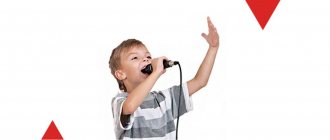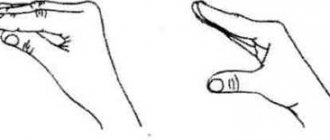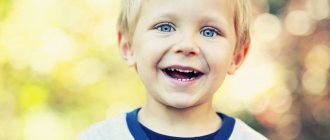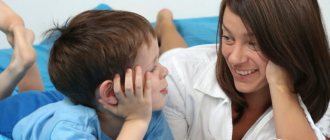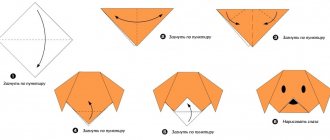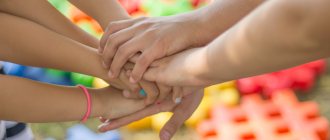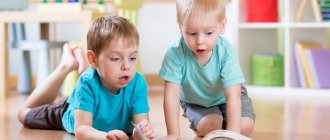The use of facial gymnastics when conducting speech therapy classes is an integral part of the work on setting and correcting sounds in children with various pronunciation disorders (general insufficient speech development, delayed speech development, dysarthria, stuttering, etc.). Facial gymnastics for children and articulation exercises, which speech therapists use when working with preschool children, make it possible to prepare muscles and nerve endings for further work on producing sounds, clear diction, and more precise movements of the articulatory apparatus during speech. They help prevent the development of unnatural articulatory movements, allow you to relax the muscles of the face, and train the use and control of the muscles of the tongue, lips, and palate. These goals are pursued by both static and dynamic exercises.
Recommendations
To get a good result, you must follow a number of recommendations:
- Perform all exercises in front of a mirror. Ideally, this should be a large mirror in which the preschooler will see both himself and the speech therapist;
- focus on only one muscle group when performing an exercise;
- perform the exercises smoothly, rhythmically and calmly, without making significant effort.
Below are various exercises, the purpose of which is to develop and strengthen facial muscles with step-by-step descriptions.
Relaxation mood
"Air balloons"
Imagine that you are all balloons, very beautiful and cheerful. They cheat you and you become lighter and lighter. Your whole body becomes light and weightless. And the arms are light, and the legs have become light, light. The balloons rise higher and higher. A warm gentle breeze is blowing, it gently blows on each ball... (pause - stroking the children). Blows on the ball..., caresses the ball... You feel at ease, calm. You fly where the gentle breeze blows. But now it's time to return home. You are back in this room. Stretch and on the count of three, open your eyes. Smile at your balloon.
"Clouds"
Imagine a warm summer evening. You lie on the grass and look at the clouds floating in the sky - such white, large, fluffy clouds in the blue sky. Everything around is quiet and calm, you feel warm and comfortable. With each inhalation and exhalation, you begin to slowly and smoothly rise into the air, higher and higher, towards the very clouds. Your arms are light, light, your legs are light. your whole body becomes light as a cloud. Here you are swimming up to the largest and fluffiest, most beautiful cloud in the sky. Closer and closer. And now you are already lying on this cloud, you feel how it gently strokes you, this fluffy and tender cloud... (pause - stroking the children). Strokes..., strokes... You feel good and pleased. You are relaxed and calm. But then a cloud dropped you into the clearing. Smile at your cloud. Stretch and on the count of three, open your eyes. You had a good rest on the cloud.
“Lazy People”
Today my children did a lot of activities, played and were probably tired. I suggest you be a little lazy. Imagine being lazy and lounging on a soft, soft carpet. Everything around is quiet and calm, you breathe easily and freely. A feeling of pleasant peace and relaxation covers your entire body. You rest quietly, you are lazy. Your hands are resting, your legs are resting... (pause - stroking the children). Your arms are resting..., your legs are resting... Pleasant warmth covers your whole body, you are too lazy to move, you feel good. Your breathing is completely calm. Your arms, legs, whole body are relaxed. A feeling of pleasant peace fills you from within. You rest, you are lazy. Pleasant laziness spreads throughout the body. You enjoy complete peace and relaxation, which brings you strength and good mood. Stretch, shake off your laziness and, on the count of three, open your eyes. You feel well rested and in a cheerful mood.
"Waterfall"
Imagine that you are standing near a waterfall. Wonderful day, blue sky, warm sun. The mountain air is fresh and pleasant. You can breathe easily and freely. But our waterfall is unusual; instead of water, soft white light falls in it. Imagine yourself standing under this waterfall and feel this beautiful white light flowing over your head. You feel it pouring over your forehead, then over your face, down your neck... White light flows over your shoulders... helping them become soft and relaxed... (pause - stroking the children). And the gentle light flows further along the chest of..., along the stomach of... Let the light stroke your hands and fingers. The light flows through your legs and you feel how your body becomes softer and you relax. This amazing waterfall of white light flows around your entire body. You feel completely calm, and with each breath you relax more and more. Now stretch and on the count of three, open your eyes. The magical light filled you with fresh strength and energy.
"Puffing up the cheeks"
Puffing out our cheeks:
- “fat tomatoes” - puff out our cheeks;
- “skinny parsley” - suck in the cheeks;
- alternately inflate the right and then the left cheeks;
- round your mouth as when pronouncing the sound “o”;
- stretch out your lips with a tube;
- wrinkle your nose and say “ugh” in a whisper;
- smile showing closed teeth
You can do exercises with a child (or a group of children) in a playful way. The game will interest them more than simply performing movements in front of the mirror. Below are a few such games.
Examples of exercises
Here are some simple exercises for developing facial expressions that you can do at home.
- I'm surprised (raise eyebrows high).
- I'm angry (the kid frowns, without moving his lips).
- I was scared (the child opens his eyes wide).
- A mean smile (the preschooler smiles only with his closed lips, his eyes are not involved).
- Crooked smile (only one corner of the mouth is involved, moving towards the ear). Repeat on the other side, then alternate.
- Fish. Open your mouth, hold until count 5, close;
- Saw. The hand rests on the chin, the baby moves the lower jaw to the sides without turning the head.
- Ruminant. The preschooler moves his lower jaw in turn in all directions (up and down, forward and backward).
- I smell it. The baby flares his nostrils, inhaling.
- Tricky. You need to narrow your eyes like slits.
- Contempt. When smiling, the child wrinkles his nose and raises his upper lips.
- Disgust. The lower lip must be pulled down.
- Blind Man's Bluff. The baby needs to forcefully close and open his eyes.
- I'm falling asleep. The child slowly closes and opens his eyes.
- On the alert. The eyes are closed one by one.
- I wink. A preschooler winks first with one eye and then with the other.
You can find many similar exercises and games for preschool children. They are not a miracle cure; you should not rely only on them if the child has a serious diagnosis. But in combination with other activities and treatment (when it is indicated), facial gymnastics makes a significant contribution to the correction of sound pronunciation in children. And, as you know, you shouldn’t postpone this process, otherwise you could waste precious time.
Game "Masks"
Various game options are possible.
Equipment: masks depicting various emotions (sadness, joy, surprise, boredom, melancholy, fear), as well as fairy-tale characters.
First option
The teacher puts on the masks one by one (or simply shows them) and asks them to repeat the facial expression depicted on the mask and name it. The actions are accompanied by explanations from the teacher.
Questions to discuss the game:
- What emotions do you most often observe in your friends (mother, grandmother, teacher, passers-by)?
- Are you pleased to see these emotions yourself?
Second option
The speech therapist invites preschoolers to name the facial expressions of familiar characters from fairy tales:
- What is Barmaley's facial expression?
- What kind of bun is it?
- Imagine that you have become a kind Santa Claus (the sad Princess Never Laughed). What is his facial expression?
Third option
The group is divided into two parts. One decides which fairy-tale character she will show, and the second must guess from her facial expressions who the children are portraying. Then they change places.
On the topic: methodological developments, presentations and notes
Young children (due to their age) are not able to cope with a large number of emotions, which significantly complicates the process of learning about the world around them. Therefore, the main task is to...
Summary of an integrated lesson on speech development, with musical elements, based on health-saving technologies (psycho-gymnastics, facial gymnastics, relaxation).
This material is intended for practicing speech therapists and parents of children suffering from dysarthria.
Facial gymnastics helps in developing mobility and strengthening facial muscles. With systematic, correct and long-term performance of facial exercises, children are better able to do many words.
Memo for parents “Mimic gymnastics for children.”
The manual reveals: why facial gymnastics is needed, recommendations for performing facial gymnastics, exercises for the development of facial muscles (purpose, description, poem, visual image.
The need to develop these movements is due to the fact that children suffering from various forms of dysarthria have weak tone of the facial muscles, inexpressive facial expressions, etc.
Source
Silent movie
The Silent Movie game is also available in several variations:
The speech therapist “turns” into a TV that has no sound, and asks you to guess from his gestures and facial expressions what he wants to say (praises, scolds, rejoices, gets scared, points to an object, asks to bring it or take it away, calls someone... either to himself or asks to leave). After this, the children and the teacher change roles.
- Preschoolers are divided into two groups. They must imagine that they are standing on different banks of a very stormy river. The first group is given the task of “telling” without words those standing opposite that they need to hide, as they are in great danger.
- Children should show fear, joy, fatigue, anger, surprise with one gesture or facial expression.
Rules for performing facial gymnastics
You can do facial gymnastics for children even at home, with your mother or another adult. In this case, you need to follow the recommendations.
- Classes are held daily, for 5-10 minutes.
- First, parents need to master the exercise themselves in order to show it to their child.
- The baby should be calm and comfortable. It is important that he feels good.
- For practice you will need a fairly large mirror. It is necessary for the child to see how he performs the exercise. A mirror is also needed to observe an adult who is doing the exercise next to him.
- It is not the quantity of exercises done that is important, but their quality.
- The tongue, lips or jaw should not tremble from tension. It is necessary that the movements occur calmly, without jerking.
- First, they perform a set of static exercises, then proceed to dynamic ones.
- In dynamic exercises, transitions between movements are made quickly and smoothly.
- The exercises are repeated 3-5 times, then take a short break. After this, you can start the task again.
- To make classes interesting, you should use colorful pictures or dolls with clear, expressive facial expressions.
- If a child is unable to do an exercise, you should put it off for a while, but then be sure to return to it.
- It is important to praise your child and celebrate his successes.
- You can’t scold your child if something doesn’t work out for him.
"Name Day"
Two versions of the “Name Day” game:
- Children stand in a circle and choose one birthday person. The rest play the role of donors. The birthday boy decides what kind of fairy-tale character he wants to be and tells the others about it. The givers decide which character the gift would be suitable for (the character can be either magical or real), then without words, using only gestures and facial expressions, they present it to the birthday person. The birthday boy must guess what the gift is and thank him. Children take turns playing the role of the birthday boy.
- The birthday boy decides for himself what kind of fairy-tale hero he will be, but does not tell anyone. With facial expressions and gestures he tries to communicate the chosen role. The teacher invites the children to guess who their friend is portraying and what they can give him.
Question after the game:
Which gift did the hero like best?
"Shapes"
Two groups of children. One portrays a famous magical character, and the second tries to find out who their comrades are showing. Then they change places. You can also depict various emotions, and not just fairy-tale characters (a joyful, sad, frightened person). According to the terms of the game, “Figures” are exhibits in a museum. But if you correctly guess who is depicted, the figure comes to life.
The variety of techniques, exercises, and games used to develop and strengthen facial muscles is quite large. Unfortunately, they cannot fit into one short article. With almost every articulation exercise, you can use poetry to make the child more interested and involved. It is important to understand that only systematic classes conducted by an experienced speech therapist, supported by the work of preschool teachers, as well as the homework of parents and their baby, bring good results.
On the topic: methodological developments, presentations and notes
Young children (due to their age) are not able to cope with a large number of emotions, which significantly complicates the process of learning about the world around them. Therefore, the main task is to...
Summary of an integrated lesson on speech development, with musical elements, based on health-saving technologies (psycho-gymnastics, facial gymnastics, relaxation).
This material is intended for practicing speech therapists and parents of children suffering from dysarthria.
Facial gymnastics helps in developing mobility and strengthening facial muscles. With systematic, correct and long-term performance of facial exercises, children are better able to do many words.
Memo for parents “Mimic gymnastics for children.”
The manual reveals: why facial gymnastics is needed, recommendations for performing facial gymnastics, exercises for the development of facial muscles (purpose, description, poem, visual image.
card index for senior preschool age.
Source

